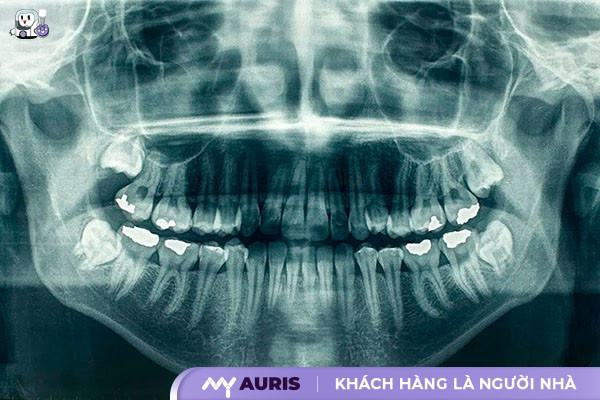Whether dental implant placement allows for X-rays is a common question among many who have undergone implant surgery. X-ray images are modern imaging techniques that help dentists clearly visualize the jawbone, aiding in the accurate diagnosis of oral health issues. So, do X-rays affect implants? Let’s find out in detail!
Can You Have X-rays After Dental Implant Placement?
The answer is yes! You can absolutely have X-rays after dental implant placement. Although X-rays cannot penetrate metal, implant posts are typically made from Titanium or stainless alloys – materials that are not affected by X-rays, thus ensuring clear, sharp images without interference or blurriness. This is a key difference compared to Magnetic Resonance Imaging (MRI), which can be susceptible to interference if metal is present in the body.
Before the X-ray, your dentist will instruct you to remove any metal objects such as necklaces, earrings, or temporary dental implants in the imaging area to ensure accurate and complete X-ray images.
If you are considering dental implant placement, don’t forget to thoroughly research the cost of implant placement – as the price will vary depending on the type of implant post, the condition of your jawbone, and the dentist’s expertise. A clear treatment plan not only optimizes dental function but also provides comprehensive aesthetic results.
Additionally, many people wonder if dental implants can be combined with braces. In reality, in many cases, these two methods can be flexibly combined to achieve high effectiveness in both aesthetics and chewing function. However, this requires specific consultation from a specialist dentist after evaluating the overall oral health condition.

Two Groups of Patients Who Need Caution When Having X-rays After Implant Placement
Normally, dental implants are not affected by X-rays, so having X-rays after implant placement is safe in most cases. However, there are some groups of patients who need special attention to ensure maximum health:
Pregnant Women
During pregnancy, especially in the first trimester, doctors usually do not recommend X-rays, even after implant placement. The reason is that X-rays can affect fetal development, which is in a critical stage of forming important organs such as the heart, brain, and central nervous system.
Exposure to X-rays at this time can increase the risk of birth defects or long-term effects on the baby’s health later on. Therefore, doctors always carefully consider the benefits and risks before ordering an X-ray for pregnant women. If you are wondering whether dental implant placement involves anesthesia, please refer to current safe pain relief methods to feel more confident before treatment.

People with Serious Medical Conditions
For individuals with serious medical conditions, especially cancer patients undergoing treatments such as chemotherapy or radiation therapy, X-rays must be considered with caution. Because X-rays are a form of ionizing radiation, they can exacerbate cell damage and weaken the immune system already compromised by the illness.
Furthermore, exposure to X-rays during this period carries the risk of reducing the effectiveness of primary treatment therapies, and can even disrupt the treatment plan if not properly managed. Therefore, doctors will only prescribe X-rays when absolutely necessary and after a thorough evaluation of the patient’s condition.
Important Notes When Implant Patients Need to Undergo MRI
Based on studies published in medical literature, My Auris provides some medical recommendations for patients who have undergone dental implant placement when an MRI is indicated, to ensure oral health and the accuracy of image quality:
Currently, most dental implant posts are made from Titanium, a non-magnetic metal, so they do not affect MRI machines. Additionally, dental implants do not distort images during MRI scans, so patients can rest assured when undergoing this procedure if indicated.
A dental implant consists of three parts: the implant post (Titanium), the prosthetic tooth on the implant, and the connecting screw. In cases where the prosthetic tooth contains metal or 4% Titanium, you should ask your dentist to remove the prosthetic tooth before the scan. Removing and reattaching the prosthetic tooth is very quick and does not affect the implant post. After the scan is complete, the dentist will reattach it as before for your normal use.

If conditions permit, you should choose all-ceramic teeth without metal attached to dental implants. Since all-ceramic teeth are non-magnetic, they do not need to be removed for MRI scans, especially as one might need multiple MRI examinations in old age.
During the removal and reattachment of the prosthetic tooth, the dentist will temporarily place a healing abutment (healing cap) or cover screw to protect the implant site. These materials are also made from Titanium alloy, ensuring absolute safety during MRI scans.
The above information applies only to dental implants and is not suitable for patients with cardiac stents, cochlear implants, or metal splints in the head and neck region. Always consult your dentist before undergoing an MRI to ensure maximum safety.





